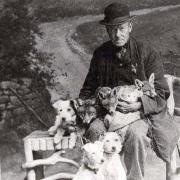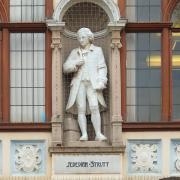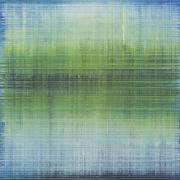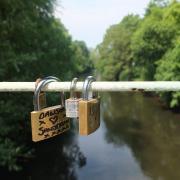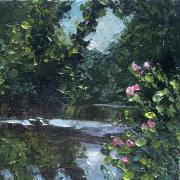Peter Seddon visits Eyam to ponder the unique grave of old Derbyshire cricketer Harry Bagshaw.

It’s been said that ‘old cricketers never die’ – they are simply ‘given out’, called to the shimmering pavilion in the sky by the great umpire. The sentiment is embraced by cricket-lovers, for the summer game seems a fitting metaphor for the fickle undulations of life and the death which surely follows.
Footballers have 90 minutes to make it count – but a cricketer at the crease faces the nagging uncertainty that the next ball may be the one that brings their innings to a close. Sometimes this happens when they least expect it. Up goes the umpire’s finger – ‘That’s out’.
This might explain the marked tendency for cricketers in particular to adorn their graves with associated symbolism – a trait exemplified by Derbyshire all-rounder Harry Bagshaw (1859-1927).
All graves are monuments to a life – but in Bagshaw’s case more quirkily expressed than the average. So much so that cricket enthusiasts visit the plague village of Eyam especially to seek out his final resting place.

St Lawrence’s Church has helpfully provided a marker stone pointing to ‘Cricketer’s Grave’. There it reveals itself: ‘To the dear memory of Harry Bagshaw’ – below his name a bat, ball and wicket nicely etched on black marble, the ball casting the stumps asunder. And at the gravestone’s apex the raised forefinger pointing unerringly to the heavens – a touch of humour even in death.
There is a knowing poignancy too in the inclusion of some celebrated lines: ‘For when the great scorer comes to write against your name, He writes – not that you won or lost, but how you played the game.’ A noble sentiment…
Yet many visitors to this unusual cricketing monument depart with little but a captured image – for they omit to ask the fundamental questions: Who was Harry Bagshaw? And how did he play the game?
Henry ‘Harry’ Bagshaw was born in the Derbyshire hamlet of Foolow – between Eyam and Tideswell – on 1st September 1859, to lead miner William Bagshaw and his wife Martha, both from humble roots in rural Derbyshire.

Late in his life Harry recalled his introduction to cricket: ‘I’d be no more than six when my grandmother used to sit in the garden porch and bowl to me. It lasted a few years until I broke the parlour window – then came cricket on the “highway” beside the village pond.’
That idyllic-sounding Foolow childhood masks a starker truth. By the tender age of eleven Harry had finished school and was working in the lead mine at Great Hucklow. Cricket became a release from this harsh life and he practised assiduously to progress, playing local cricket first for Foolow and then Tideswell when both fielded sides of some repute.
This determined approach to life remained in Bagshaw’s consciousness even after he had succeeded in professional cricket, first as a player and later as a first-class umpire. In a post-retirement interview for the Athletic News in 1925 he recalled: ‘When aged 17 I volunteered many a time to work the night shift in the lead mines in order to be able to play cricket the following day.’
Bagshaw left readers in no doubt that cricket was preferable to the mines: ‘Between innings in later years I often pondered those experiences, going down the iron staves of the ladder 160 yards long with a candle embedded in a lump of clay, to work through the night, often alone.’
And he was wise enough to know what the relentless pursuit of his passion had given him: ‘I have always considered it to have been well worthwhile. Few men regret the hours of toil and practice spent in becoming proficient at cricket.’
There Bagshaw signposts that it was far from easy to become a paid cricketer. Indeed he failed to take his first big opportunity. Selected to try out for Derbyshire in a Colts XI in 1880 as a ‘promising young batsman’ he ‘bagged a pair’ – in cricket shorthand ‘a pair of spectacles’ – a ‘double duck’, two noughts.
But having faltered he persevered, and in 1887 fully seven years later, then aged 27, Bagshaw began his first-class career with Derbyshire in a match against the MCC at Lord’s. Perhaps bad memories plagued him, or he was unnerved by the revered venue, for Harry again bagged ‘a pair of specs’ – but Derbyshire stuck with him. He played for his county until 1902, stepping down aged 43 to pursue a second career as umpire from 1907 to 1923 – that’s over four decades in the game he loved.
In tandem with his Derbyshire appearances Bagshaw was contracted as resident professional with first Barnsley Cricket Club – six summers 1887-92 – and afterwards Glossop at a time when town clubs playing in League cricket commanded enthusiastic followings. He also had spells coaching on matting wickets in Holland and at the Public School Bradfield College in Berkshire.
At Barnsley he garnered folk-hero status, scoring almost 4,000 runs and taking 500 wickets at an average of less than 10 runs each – excellence at any level. Sadly his tenure there ended badly, Barnsley dispensing with his services when Bagshaw defied the club’s orders not to play for a county Select XI against the Australians. He did play and was promptly dismissed.
This suggests that Bagshaw was very much his own man. His cricketing style bore this out. He bowled right-handed and batted left-handed, adopting an unconventional square-on stance that purists were inclined to criticise. Nor was he particular about fitness – the Derby Daily Telegraph painted a colourful picture: ‘Bagshaw was a man of heavy build, big and burly with an awkward gait. With the bat he was fearless, but his blows were often lusty rather than elegant, and he held his bat very high in the handle. In the field he was most ungainly, so generally employed in the slips.’
Evidently he was no athlete – but he got results. Bagshaw scored seven first-class centuries – three reserved for Derbyshire’s traditional cricket rivals Yorkshire. In 125 first-class matches he hit 5,456 runs with an innings average of 26.1. As a medium-paced bowler he achieved first-class career figures of 73 wickets at an average of 29.02 runs per wicket.
But these first-class figures were the mere tip of an iceberg – he also appeared for Derbyshire in their exiled period when they were designated ‘second-class’, and adding in his Barnsley and Glossop figures he amassed a prolific record.
As a character Bagshaw was down-to-earth. Facing County Champions Surrey at the Oval in 1891 against a pair of star bowlers he discussed tactics mid-wicket with batting partner William Chatterton: ‘I reckon I can wharm these two.’ Chatterton urged him: ‘Well wharm ’em then.’ Bagshaw scored 80 and a chastened Surrey suffered their first defeat of the season – beaten by 10 wickets.
As his gravestone suggests, he had something of a gallows humour. A story he liked to tell against himself was of being dismissed for a duck playing on rival turf: ‘The local brass band played me back to the pavilion with the Dead March from Handel’s Saul.’
By the time he ended his Derbyshire career in 1902 Bagshaw had supplemented his income with stints in the licensed trade. In the 1890s he was ‘mine host’ at the Station Inn in Norfolk Street, Glossop, and later until his death ran the ancient coaching inn the George and Dragon (long-since demolished) near the northern outpost of Crowden in the High Peak, the latter while forging an excellent reputation as a ‘firm but fair’ first-class umpire.
All this was achieved with family support – but not without hardships. In 1882 he had married Emma Young – the couple had five children before Emma died in 1900 aged only 37. Two years later he married Jeannie Wingfield a native of Calow – and had two more children.
Jeannie survived him. After bouts of illness Harry Bagshaw died aged 67 at his home the George and Dragon on 31st January 1927. At his request his coffin was driven on a 30-mile meandering route from Crowden to Eyam taking in his childhood haunts and places he had played cricket. A large throng gathered at the graveside to pay their last respects.
So there is the story of an unusual Derbyshire grave and its occupant – although not quite the full story. Bagshaw played one final stroke. He was buried in his white umpire coat with his six ‘counting pebbles’ in its pocket and a cricket ball clasped in his right-hand.
There is something mildly macabre in the thought that the remnants of those accoutrements must yet adorn Bagshaw’s skeletal remains. But one imagines Harry would be mischievously-pleased at the effect – he may be ‘out’ but his memory still entertains.
Derbyshire begin their 2019 campaign on 26th March. The summer promises an entertaining programme including games against Yorkshire, Nottinghamshire, Leicestershire and the touring Australians. Were Harry Bagshaw to issue advice from beyond the grave it might well go like this: ‘Go to it Derbyshire – go out and wharm the lot of ’em.’










